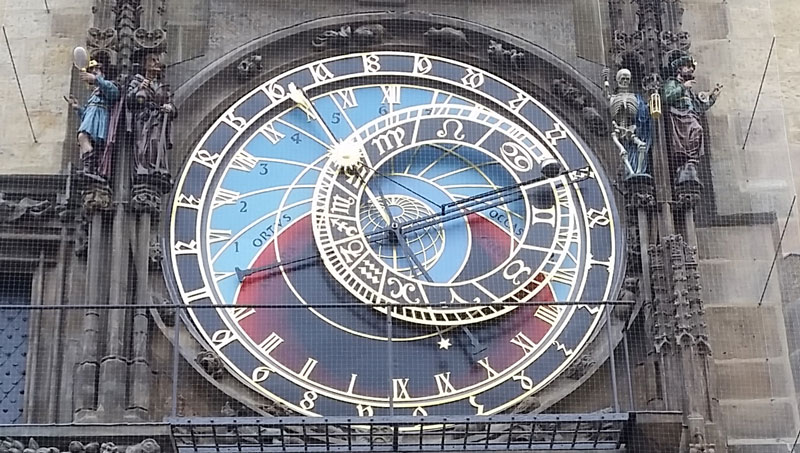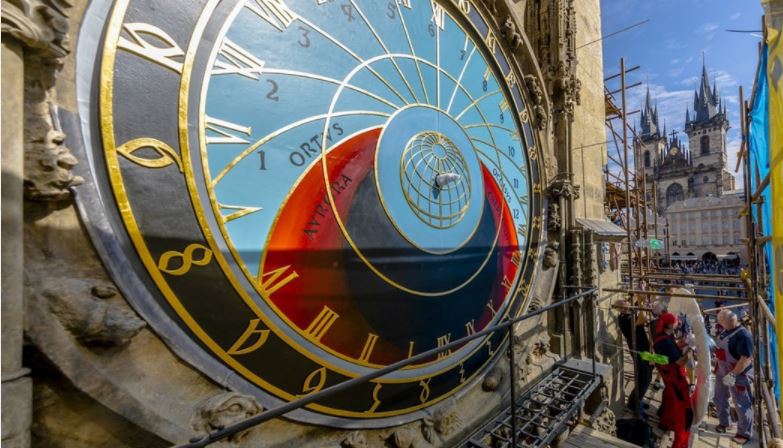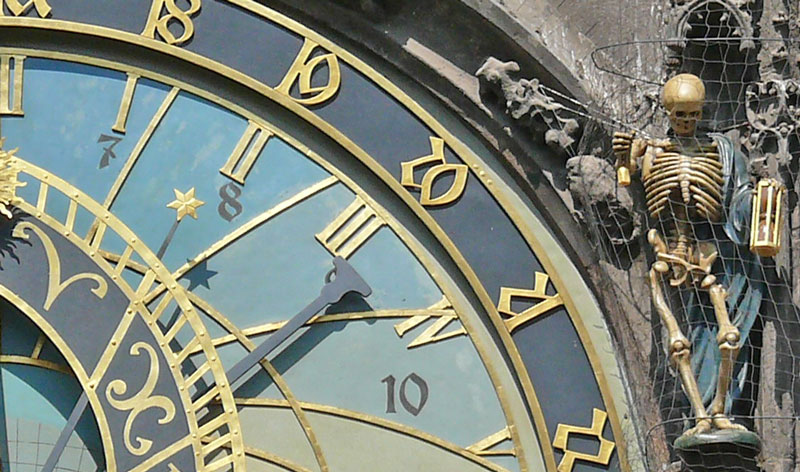How to Tell the Time on the Astronomical Clock
When you look at the Astronomical Clock in Prague it’s like a mass of numbers, lines, colours and moving parts. So to make it less complicated I’m going to explain to you how to read the current time and how to understand Old Czech Time as well. We are not going into the Astrological stuff on this post, it’s strictly about time. Look at the picture below. It’s telling me that it’s 10am, I’ve got 8.5 hours of daylight left and there’ll be a half-moon. How do I know this?

First lets strip off all the moving parts and anything relating to the Astrological part i.e. the smaller ring of the Astronomical Clock and restrict ourselves to colours, words, numbers and figures. So what that would look like is shown below.
Colours
First understand how the face is divided into colours. The big black circle at the bottom indicates “Astronomical Night”. The orange areas are “Twighlight”.

Bottom left it’s the twighlight before dawn and you’ll see the word “AURORA” (coming of dawn) and then as you cross the gold line you have “ORTUS” (Latin for sunrise).
Bottom right it’s the twighlight before dusk labelled “CREPUSCULUM” (coming of darkness) and then as you cross the gold line you have “OCCASUS” (Latin for sunset).
Everything above is a shade of blue which indicates “Astronomical Day” but for you on this post the most important part is that you can identify the position for sunset.
Lines
There are many golden lines on the clock. There are circles which denote the Tropics and the Equator but as far as this post is concerned, they do not interest us. The curved lines are called eliptics and would be used if you were looking at planetary time using the figures for the sun and the moon and the Astrological constellations but again, not covered on this post. Possibly the most interesting lines are right in the centre. They form a sphere like the earth and shows the position of Prague in the Northern Hemisphere (before the renovation it was a map of Europe).
Tour Tips: Here are two ways to get into the Astronomical Clock Tower to go up to the scenic gallery and see into the mechanism that turns the apostles. One is buying a standard entry ticket just for the tower. The other still gives you access to the tower but also includes a tour into the underground Romanesque cellars of the building.
Numbers
There are three sets of numbers on the clock. Ignore the black numbers. Now you have Roman numerals on the inside ring of the clock starting at XII in the 12pm position and going around clockwise to XII in the 6pm position. Then it repeats so you have two sets of twelve.
Around the outside edge of the clock are the numbers 1 to 24. These relate to something called “Old Czech Time” which was not so much about telling the time but how much time you had before dusk because Old Czech Time divided the day equally between 12 hours of day and 12 hours of night. Of course this will never happen so the clock has to allow for the seasons. You rarely find the 1 in the usual place.
You can pretty much forget the rest of it. The key to telling time on the Astronomical Clock is understanding the relationship between these two sets of numbers. The Roman numerals represent current time. The numbers 1-24 represent Old Czech Time. We do not need to put back the Astrological ring but we do have to add some figures. Hand, Sun, Moon and Star.
HAND

At this point, for the purposes of telling the time we only need the hand. On the Astronomical Clock it will look like it’s pointing at the outside ring of numbers. Actually that is correct if you want to know Old Czech Time. For us, we look beneath the hand to the Roman numeral for the actual time. It’s based on a mechanical cog with 365 teeth measuring the rotation of the earth around it’s own axis.
SUN
The Sun is rotating once every mean solar day which is about 4 seconds shorter than a calendar day and it’s based on a mechanical cog with 366 teeth. Again you are measuring the rotation of the sun against the Earth’s axis.
MOON
Much like the sun in that it’s not telling the current time but is allowing you to calculate how many more hours will pass before sunrise. Also the Moon rotates to show the phase.
NOTE: that the SUN and MOON are mechanically connected on the Astronomical Clock so they are unique in that they can move up and down their respective poles in relation to each other, but they are also used with the Astrological ring.
STAR

Technically this is associated with the Astrological part of the clock but it’s time related so I’ve included it. This is the least important for the common man but the most important for an astronomer. It is telling Sidereal Time and also uses the 365 teeth cog but this time it measures the rotation of the earth in relation to other planets. Simply, let’s say that you wanted to look at Mars through a telescope so you need to know where Mars is in space. If you know the date, Sidereal Time and your own point in space then you would use an Astronomical reference book to find the co-ordinates for aligning your telescope to view Mars because that’s exactly where it will be in the night sky on that date at that time.
In Summary
1) If you want the exact time, find the hand and read the time from the Roman numeral under it (add an hour in the summer).
2) If you want to calculate the sunset time, again find the hand and see how it points to a number on the outside ring between 1 and 24. Now count clockwise from that point 1, 2, 3 etc until you reach number 24 on the outside ring. The number of hours is the time until sunset.
If you are thinking that the number 1 is not next to the Orange dusk marker then don’t worry. The outside ring moves clockwise so by the time you get to dusk it will be in line. Clever!
So as complex as it is and for all the different things it can do, as far as the common man was concerned it was good for one of two things. Either the time or how much daylight was left in the day. The Astronomical Clock is included in the Old Town and Jewish Quarter Walking Tour.
Something Related or a Few Minutes Away
Attraction – House at the Stone Bell
Churches – ST Nicholas Old Town
Churches – Church of Our Lady Before Tyn
Prague Streets – Paris Street – Rebuilding the Jewish Ghetto
Prague Streets – Little Square
